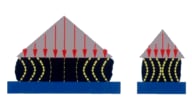Mining Topic: Pillar Design
What is the health and safety problem?
Adequate pillar design is fundamental to maintaining stable underground openings and to providing a safe work environment for underground mine workers.
What is the extent of the problem?
All underground mines that are in tabular deposits require pillars that must be designed to support the overburden. There are about 700 mines in the U.S. in these types of deposits.
How is the NIOSH Mining Program addressing this problem?

Pillar diagrams showing stress distribution.
The NIOSH Mining Program has developed guidelines and criteria for the design of longwall gateroad pillars and coal and limestone pillars used in retreat mining. These guidelines are to a large extent empirically derived and based on case histories of pillar performance from a number of mines. The case histories were incorporated into extensive databases that were then used to develop the guidelines based on the success or failure of the pillars in each case.
What are the significant findings?
The pillar design guidelines have been incorporated into software packages that can be used for the preliminary design of pillars for longwall gateroads and retreat mining in coal and in limestone mines. The software packages are:
- ALPS (Analysis of Longwall Pillar Stability) for longwall gateroad pillars in coal
- ARMPS (Analysis of Retreat Mining Pillar Stability) for retreat mining pillars
- S-Pillar, for limestone mine pillar design
What are the next steps?
Longwall pillar design under deep cover is being evaluated through the use of underground field sites and numerical modeling. The database for the design of longwall gateroad pillars is also being updated.
- ALPS - Analysis of Longwall Pillar Stability - 5.4.02
- Analysis and Design Considerations for Superimposed Longwall Gate Roads
- Analysis of Multiple Seam Stability
- Assessment of Stable and Failed Pillars in Underground Limestone Mines
- Design Methods to Control Violent Pillar Failures in Room-and-Pillar Mines
- The Ground Response Curve, Pillar Loading and Pillar Failure in Coal Mines
- Pillar and Roof Span Design Guidelines for Underground Stone Mines
- Pillar Design Issues for Underground Stone Mines
- Pillar Strength and Design Methodology for Stone Mines
- Pillar Strength in Underground Stone Mines in the United States
- Proceedings: New Technology for Ground Control in Retreat Mining
- Research Report on the Coal Pillar Recovery Under Deep Cover
- Roof Span Design for Underground Stone Mines
- Simplified Pre- and Post-Processing Technique for Performing Finite-Element Analyses of Deep Underground Mines
- Technology News 516 - ARMPS-HWM: New Software for Sizing Pillars for Highwall Mining
- Toward Pillar Design To Prevent Collapse of Room-and-Pillar Mines
- The Unpredictable Life Cycle of a Coal Pillar